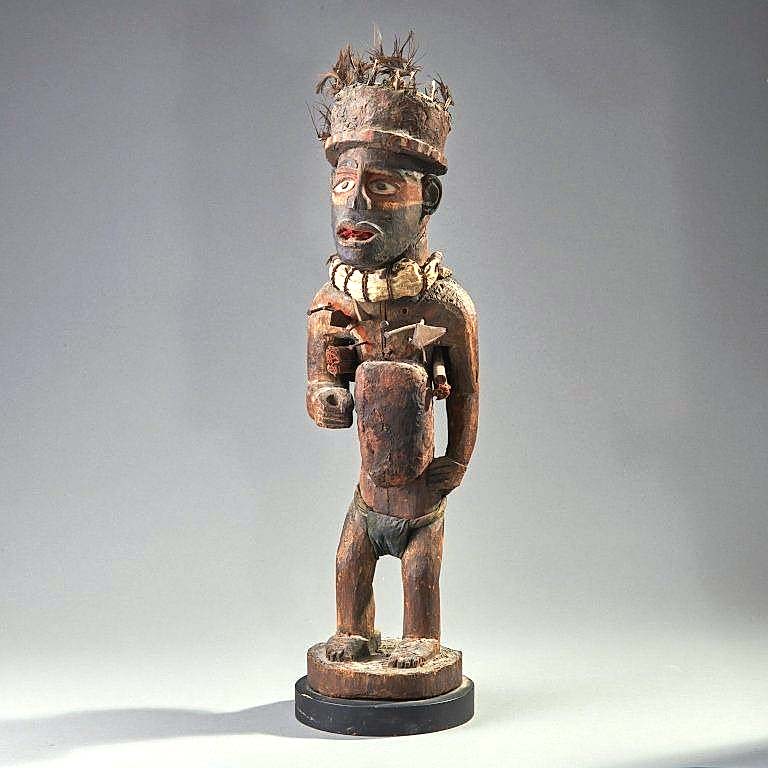
The top lot in the sale was this early Twentieth Century carved African figure, Congo, 29 inches high, which made $42,240 ($800-$2,400).
Review by Carly Timpson
CRANSTON, R.I. — On May 29, collectors of ancient artifacts and curios flocked to Bruneau & Co. Auctioneers for its 442-lot sale featuring offerings of natural history, Classical antiques and Hindu, Buddhist, ethnographic and Asian objects. Realizing $668,128, the auction had a 95 percent sell-through rate. According to Bruneau’s operations manager, Ashle Landry, “The buyers were split between private collections and dealers bidding online with telephone bids accepted, but the top winning bidders were online.”
Rising above its $800-$2,400 estimate to become the top lot in the sale was an early Twentieth Century carved African spiritual figure. Achieving $42,240, the wooden Congolese figure had inked inscription that read “38021 Majombe / R. Visser.” This inscription led Bruneau to catalog it as “likely a Linden Museum Stuttgart inventory number,” as many African artifacts acquired by Robert Visser were entered into the museum’s collection. Visser, a German merchant, photographer and collector was active in the African region (Yombe territory) in the late 1800s to early 1900s. The figure’s provenance also includes New York City art dealer Mathais Komor and, most recently, an old Rhode Island collection formed in the 1960s-70s.
A popular category among bidders was natural history, including fossils. The fossilized skull of a woolly rhinoceros, Coelodonta antiquitatis, also found a new home. Discovered in what is now Siberia, this massive skull dates to the Pleistocene epoch (2 million to 11,700 years ago) and it was in very fine condition. While keratin does not mineralize, replica horns were cast and added to the skull. This skull measured 30 inches long and 47 inches high to the top of the larger horn. Though they were likely similarly sized, unlike the rhinoceroses that are still alive today, the woolly rhino had long, thick fur, suitable for extreme cold climates. The skull was claimed for $20,480.
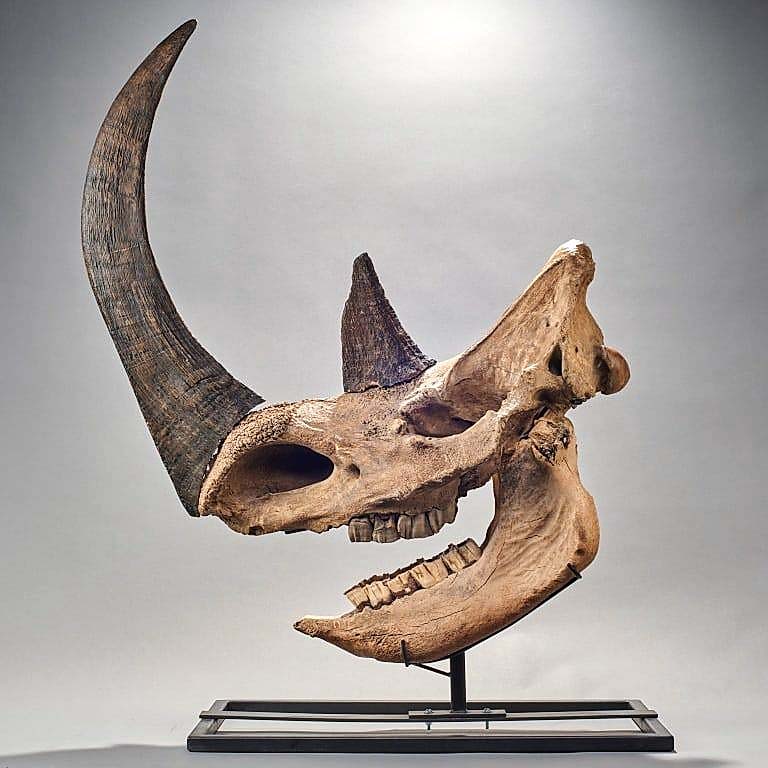
A woolly rhinoceros (Coelodonta antiquitatis) skull with cast horns, Siberia, Pleistocene Epoch (2.5 million to 11,700 years ago), 47 inches high to top of the horn by 30 inches long, hit $20,480 ($7/21,000).
In addition to natural history, religious and other ethnographic objects were also prevalent in the sale. A Tibetan gilt bronze Buddha figure from the Fifteenth or Sixteenth Century impressed bidders, more than doubling its high estimate. The crowned figure, known as Shakyamuni Buddha, is depicted in a cross-legged seated position with one hand facing upward. The figure was adorned with turquoise and coral embeadents on the crown and face. With a high estimate of $9,000, the Buddha was bid to $23,040.
Also from South Asia was a Pala Empire (circa Eighth to Twelfth Century) figure that was likely a depiction of Parvati, a mother goddess of the Himalayas. The northern Indian bronze figure was standing atop a tiered base and holding a sword and shield. Fine verdigris patina and its good condition likely helped boost bidding past its $2,400 high estimate to achieve $10,880.
A circa Nineteenth Century bronze figure depicting a female deity or attendant standing with her ankles crossed on top of an elaborate base, may have been an incense holder. The Indian piece came from the collection of South Asian antiquities dealer and gallerist Doris Wiener and was bid to $6,080.
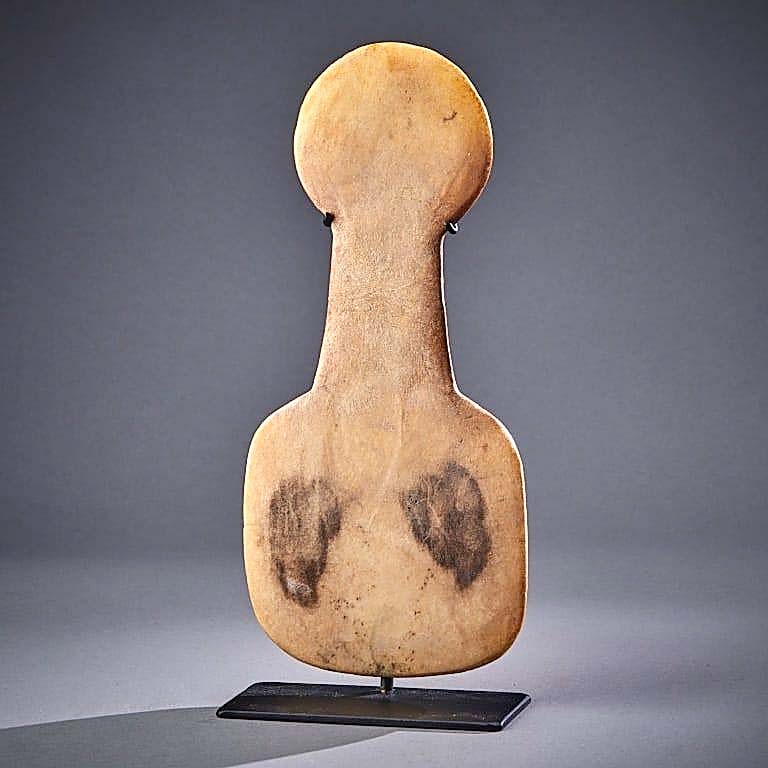
This Kusura-style marble idol, Anatolia, circa mid Third Millennium BCE, 9-3/8 inches high, found a buyer for $20,480 ($4/12,000).
An Anatolian Kusura-style marble idol of abstract form with a rounded square body, long neck and circular head was an unusual find, especially given its large size — nearly 10 inches high. Another intriguing feature was the two markings on the body. The auction catalog noted that these may have been intentional burn marks to represent breasts. The idol has notable provenance to the De Menil family collection, New York City and sold for $20,480.
Notable Egyptian items included a sandstone relief carving of a king and a broken piece of an ancient sarcophagus. The sandstone carving, from the Second or Third Century, had traces of reddish pigment on its face and measured 10½ inches high. The depicted king, facing the right, wore a tripartite wig with serpent detail and crossed the block for $12,800. The cedar fragment from a circa Sixth to Fourth Century BCE sarcophagus shot past its $2,400 high estimate to sell to an internet bidder for $5,440. The piece shows a row of finely painted hieroglyphs with a black border, with penciled completions drawn to the display’s beige ground where the images are incomplete due to the panel’s fragmentation. The sarcophagus has provenance to the collection of Richard Stuart Teitz, former director of Worcester Art Museum, the Hood Museum of Art at Dartmouth College and the Denver Art Museum.
Another Egyptian lot, this one from the First Millennium BCE, included an assorted lot of 26 faience earthware shabtis, or mummiform figures that were placed in the tomb of a loved one, representing a servant of that person in the afterlife. The assemblage came from a lifetime Massachusetts collection and included pieces from various periods and of different sizes, with the largest being 5¼ inches tall. Competitive bidding drove the lot to $5,120.
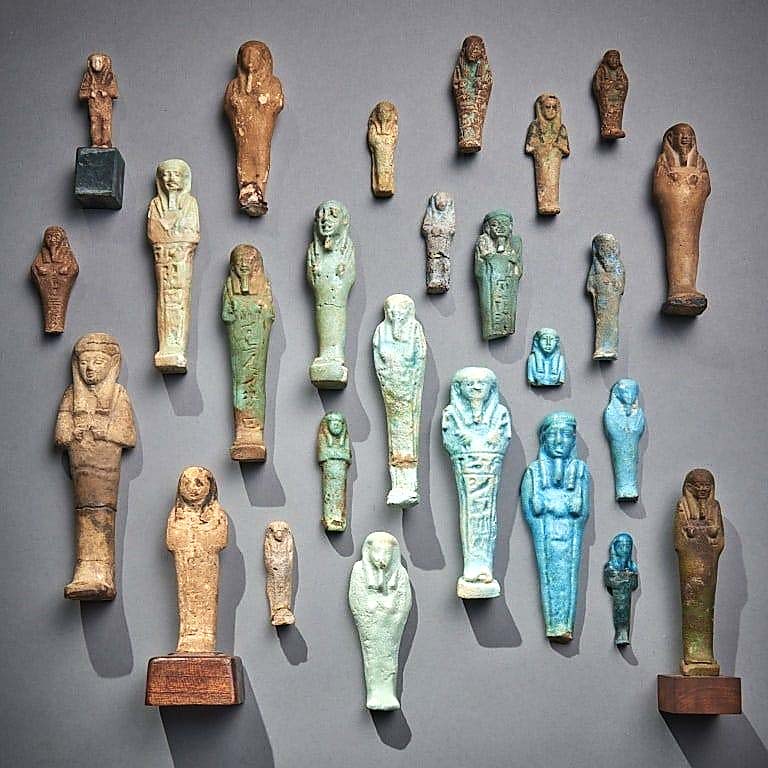
This assorted lot of Egyptian shabtis, circa First Millennium BCE, included 26 figures, with the tallest being 5¼ inches high; the collection sold for $5,120.
A celadon- and russet-colored jade carving of a seated scholar from the Ming dynasty (Fourteenth to Seventeenth Century) came from an old Rhode Island collection and achieved $11,520. The small figure was bearded, robed and held a scroll.
Several lots of Japanese ojime beads were sold to one buyer for $12,500. In total, the collection included 40 beads made from varying materials and all with unique carved designs. Literally translating to “cord fastener,” these beads were used in Japanese carrying cases and measure under one inch in diameter. The mostly round beads included traditional carved designs such as dragons, fish, flowers, birds, rabbits, birds, skulls and human figures. Landry shared that the success of these lots “was a huge surprise!”
Labeled “Rhodian Plate,” a circa Sixteenth Century Turkish İznik plate, with an old descriptive auction tag affixed to its base, crossed the block for $3,520. The primarily green floral-scrolled plate had a red rosace at its center and additional red and blue highlights. The old label, paired with a sticker that read “SPB 51” was from a Sotheby’s Parke-Bernet auction where the New York City-based consignor originally purchased it.
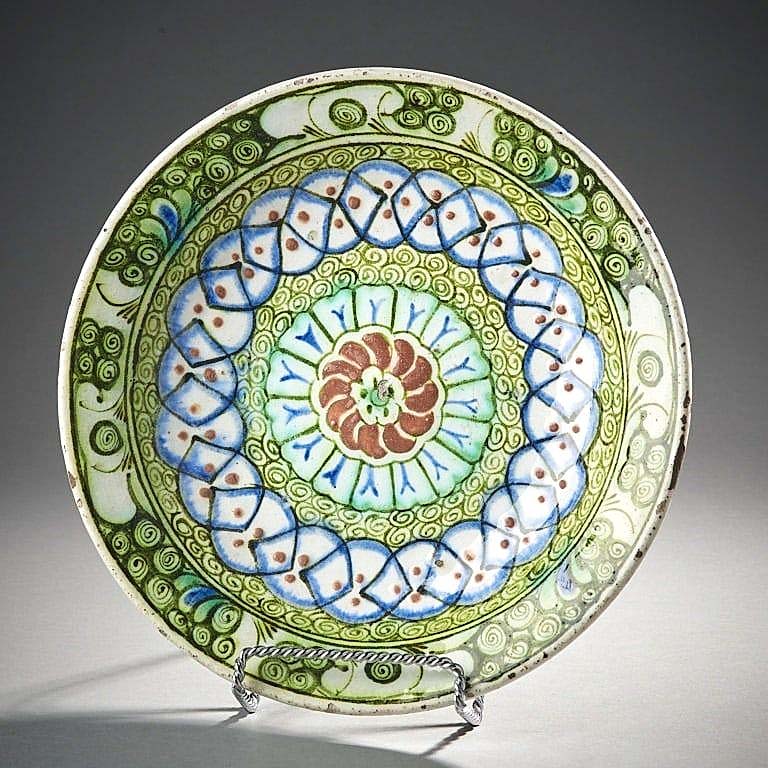
A Turkish İznik plate, labeled “Rhodian Plate,” circa Sixteenth Century, 9-7/8 inches in diameter, went out for $3,520 ($500-$1,500).
One of the more interesting catalog entries was for a Nineteenth Century carving from Greenland that finished at $2,880. Catalog notes identified the figure as a “bizarre Tupilak monster, or transformational swimming figure, with secondary face emerging from hindquarters.” According to Greenland’s tourism website, “The Greenlandic Tupilak is a carved figure that protects its owner against enemy attack.” This small figure, which resembled a seal, was paired with a custom display base and measured less than 3 inches long. Its provenance was to the collection of American and World tribal art dealer Brant Mackley, and that of Dorian Wright, who was primarily an Oceanic art collector.
Also surpassing expectations was an early Twentieth Century wooden figure from the Bijagó people of Guinea-Bissau. This spiritual iran otibago figure was considered unusual as it was seated on a stool rather than standing. With provenance to Mathais Komor and an old Rhode Island collection, the figure found a new home for $8,960.
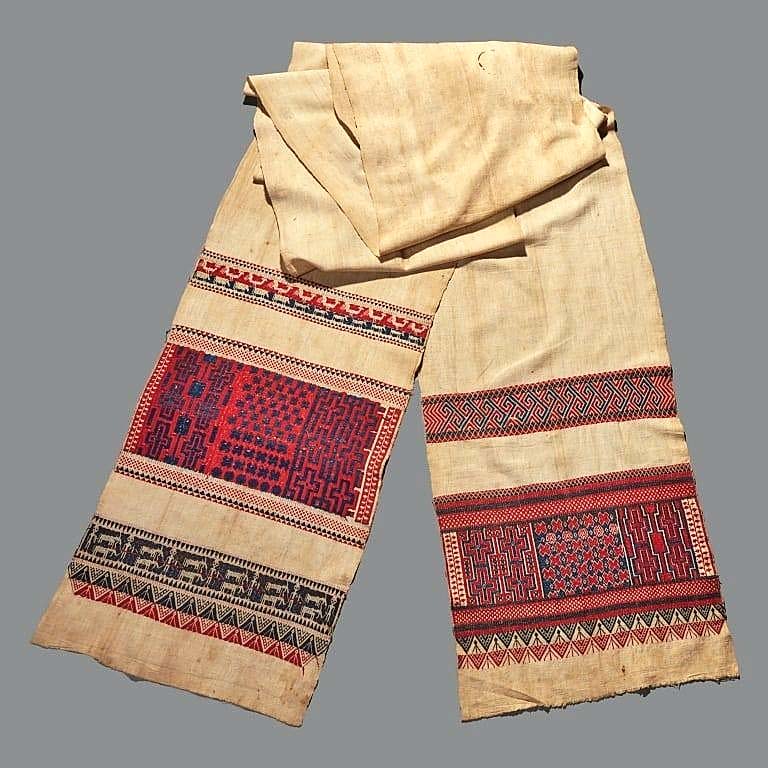
A 20-foot-long-by-16½-inch-wide Sumba sash, Indonesia, circa Nineteenth Century, more than tripled its high estimate to achieve $6,080 ($800-$1,800).
A large Indonesian Sumba sash, embroidered with red and blue geometric patterns and figural depictions of herders and their animals, that was in the same Rhode Island collection as the sale’s top lot, had some minor staining but was in good condition overall. The Nineteenth Century textile impressed bidders who took it well beyond its estimate to achieve $6,080.
Also from the Oceania region was an 18½-inch-tall carved wooden figure from the Solomon Islands. Made during the Nineteenth or early Twentieth Century, this figure was depicted as standing, with its arms bent upward to hold a human head under its chin. Despite showing age, the figure’s inlaid shell eyes were still intact, and bidders liked it well enough, taking it beyond its $1,200 high estimate to finish at $5,440.
Prices quoted include the buyer’s premium as reported by the auction house. For information, www.bruneauandco.com or 401-533-9980.




















